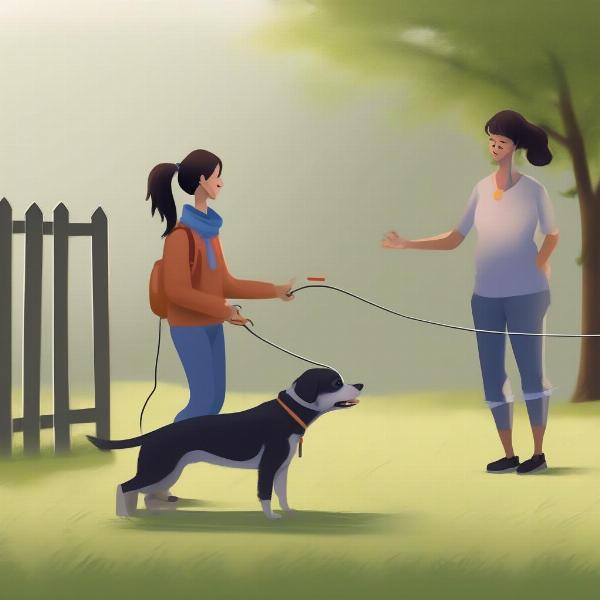Electric pet fences, often called invisible fences, can be a valuable tool for containing small dogs within a designated area. While they offer a convenient alternative to traditional physical fences, choosing and using an electric pet fence for your small dog requires careful consideration and proper training. This guide explores the key aspects of using electric pet fences for small dogs, ensuring their safety and well-being.
Understanding Electric Pet Fences for Small Breeds
Electric pet fences work by creating a boundary defined by a buried wire. A transmitter sends a radio signal through this wire, and your dog wears a receiver collar that detects the signal. When your dog approaches the boundary, the collar emits a warning tone. If your dog continues further, the collar delivers a mild static correction. This correction is designed to be a deterrent, not a punishment. It’s crucial to select a system specifically designed for small dogs, with adjustable correction levels to suit their size and temperament.
Choosing the Right Electric Fence for Your Small Dog
Several factors influence the effectiveness and suitability of an electric pet fence for your small dog. Consider your dog’s breed, personality, and the layout of your property. Some dogs are more stubborn or prone to wandering, while others are more sensitive to corrections. The size of your yard also plays a role in determining the type of system you need.
Key Features to Look For:
- Adjustable Correction Levels: This is essential for tailoring the correction to your dog’s size and sensitivity.
- Wire Break Indicator: This feature alerts you if the wire is damaged, ensuring the fence remains functional.
- Tone-Only Mode: This is helpful during the training phase, allowing your dog to learn the boundary without receiving static corrections initially.
- Waterproof Receiver Collar: Essential for dogs who spend time outdoors in all weather conditions.
Training Your Small Dog with an Electric Fence
Proper training is crucial for the successful use of an electric pet fence. It’s a gradual process that requires patience and consistency.
Steps for Effective Training:
- Flag Training: Mark the boundary of your fence with flags. This visually reinforces the area where the correction will occur.
- Introduce the Collar: Let your dog wear the collar for short periods to get accustomed to it.
- Boundary Training: Walk your dog towards the flagged boundary, allowing them to hear the warning tone. Praise and reward them for retreating when they hear the tone.
- Introduce the Correction: If your dog continues past the warning tone, allow them to experience the static correction. Immediately redirect them back inside the boundary and offer praise and reward.
- Reinforcement and Consistency: Regularly reinforce the training and ensure all family members are consistent with the commands and rewards.
 Training a Small Dog with an Electric Fence
Training a Small Dog with an Electric Fence
Safety and Precautions for Small Dogs
While electric fences can be effective, safety is paramount.
- Supervision: Never leave your small dog unsupervised in the fenced area, especially during the initial training stages.
- Collar Fit: Ensure the collar fits snugly but not too tightly. You should be able to fit two fingers between the collar and your dog’s neck.
- Regular Checks: Regularly inspect the collar and wire for any damage or wear.
- Veterinary Consultation: Consult your veterinarian before using an electric fence, especially if your dog has any health concerns.
Conclusion
An electric pet fence can be a viable option for containing small dogs, offering a less visible alternative to traditional fences. However, choosing the right system, implementing proper training techniques, and prioritizing safety are crucial for ensuring its effectiveness and your dog’s well-being. Remember, an electric fence is a training tool, not a substitute for responsible pet ownership.
FAQ
-
Are electric fences safe for small dogs? Yes, electric fences are generally safe for small dogs when used correctly with appropriate training and supervision. Choose a system with adjustable correction levels suitable for smaller breeds.
-
How do I train my small dog to use an electric fence? Training involves a gradual process of flag training, introducing the collar, boundary training, and introducing the correction, followed by consistent reinforcement.
-
What are the key features to look for in an electric fence for small dogs? Look for adjustable correction levels, a wire break indicator, a tone-only mode for training, and a waterproof receiver collar.
-
Can I leave my small dog unsupervised with an electric fence? No, it’s not recommended to leave your small dog unsupervised, especially during the initial training stages.
-
What should I do if my dog runs through the electric fence? If your dog runs through the fence, calmly bring them back inside the boundary and reinforce the training. Check the fence for any damage or malfunctions.
-
Is an electric fence suitable for all small dog breeds? While generally suitable, consult your veterinarian to determine if an electric fence is appropriate for your specific dog’s breed, temperament, and health condition.
-
How often should I check my electric fence system? Regularly inspect the collar and wire for any damage or wear to ensure the fence remains functional and safe for your dog.
ILM Dog is your trusted resource for expert advice on all aspects of dog care, from breed selection to senior dog care. We offer practical, reliable information to help you provide the best possible care for your canine companion. Whether you’re a new dog owner or a seasoned pro, ILM Dog has the resources you need to navigate the joys and challenges of dog ownership. For personalized advice or inquiries about dog products and accessories, contact us at [email protected] or call us at +44 20-3965-8624. Learn more at ILM Dog.